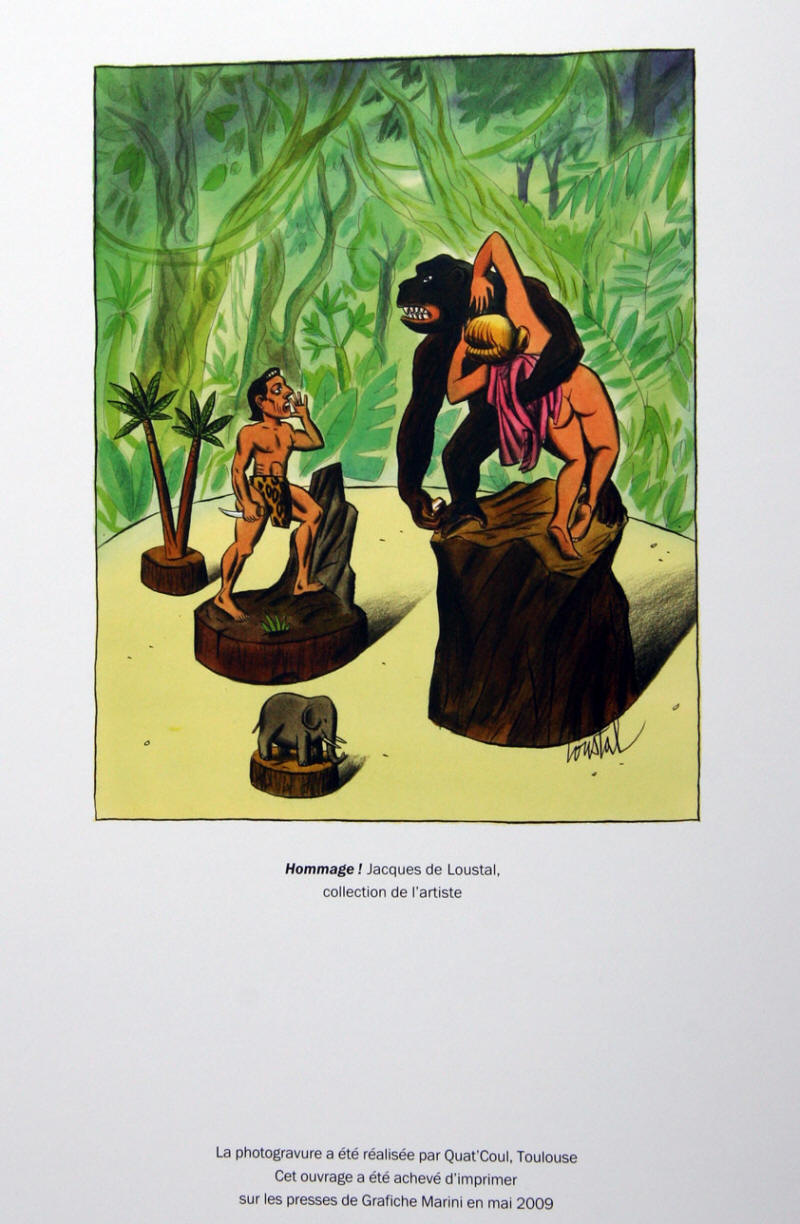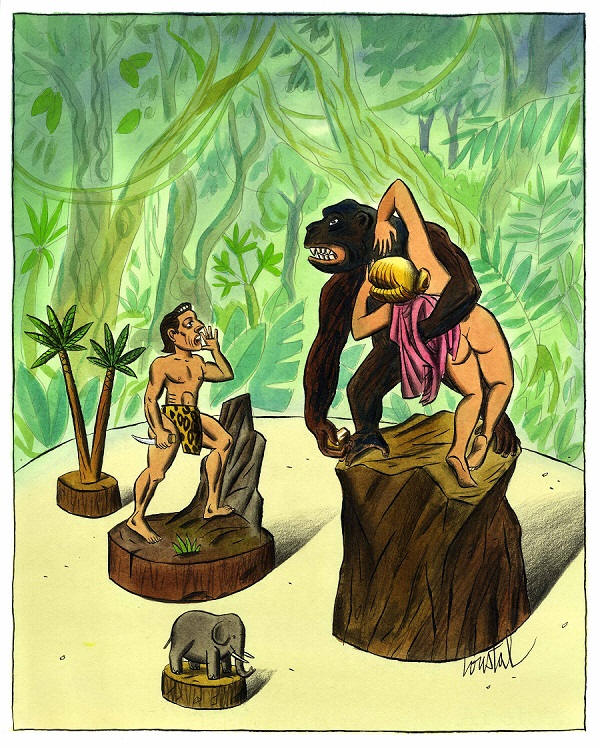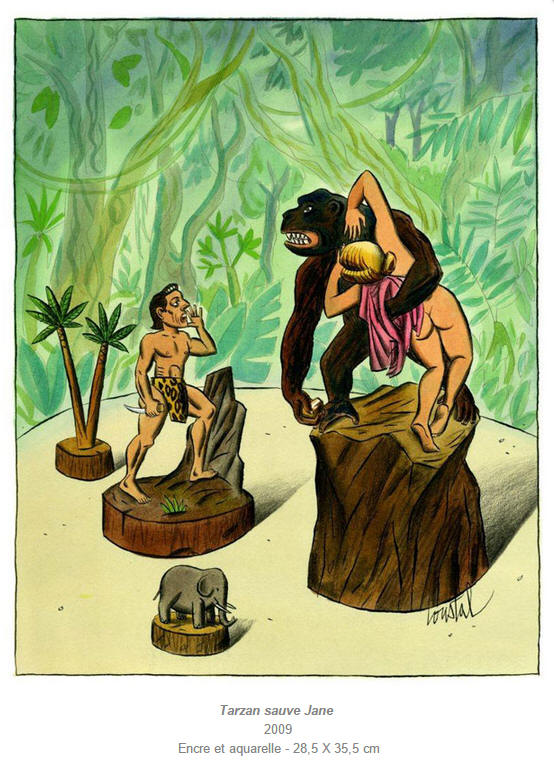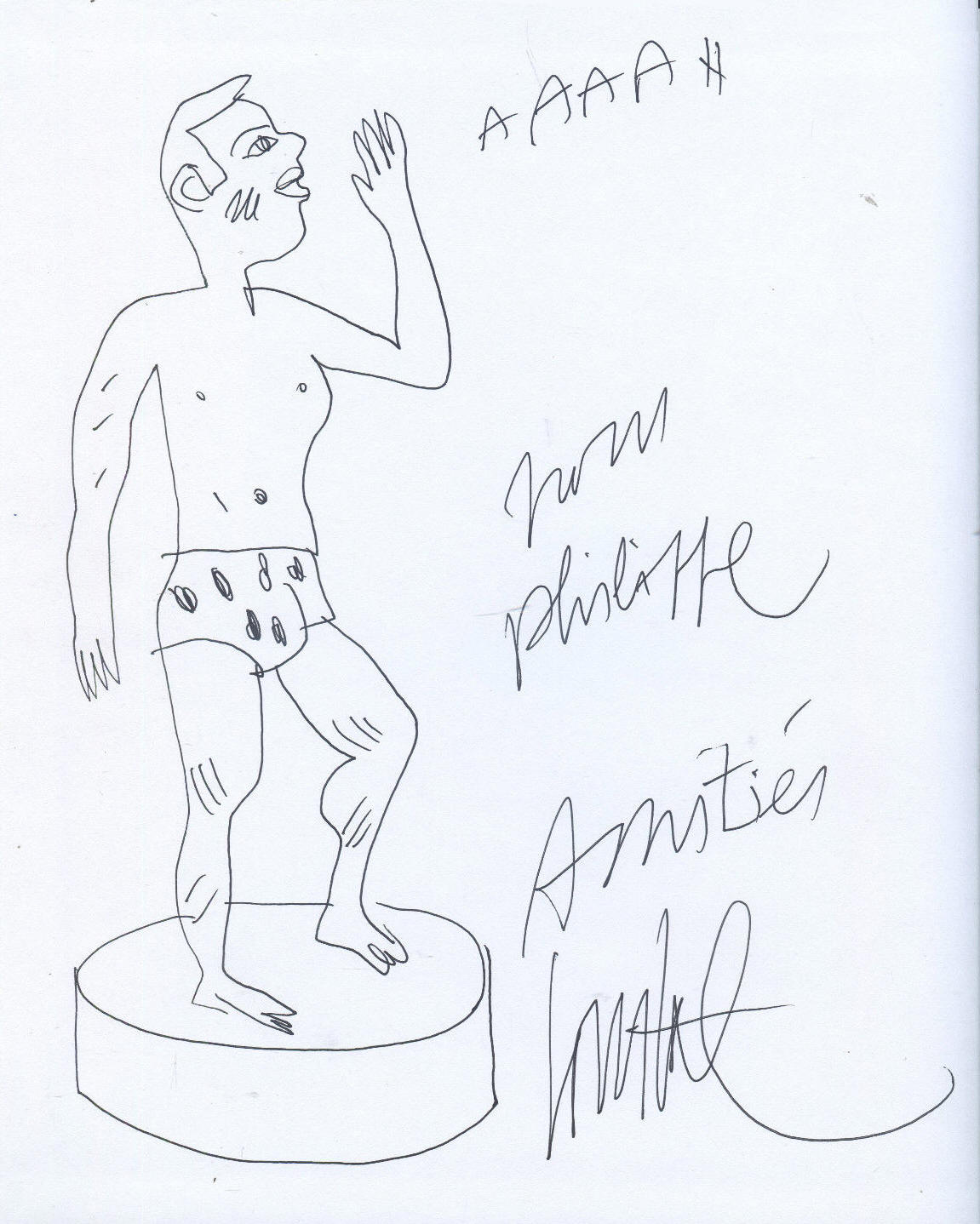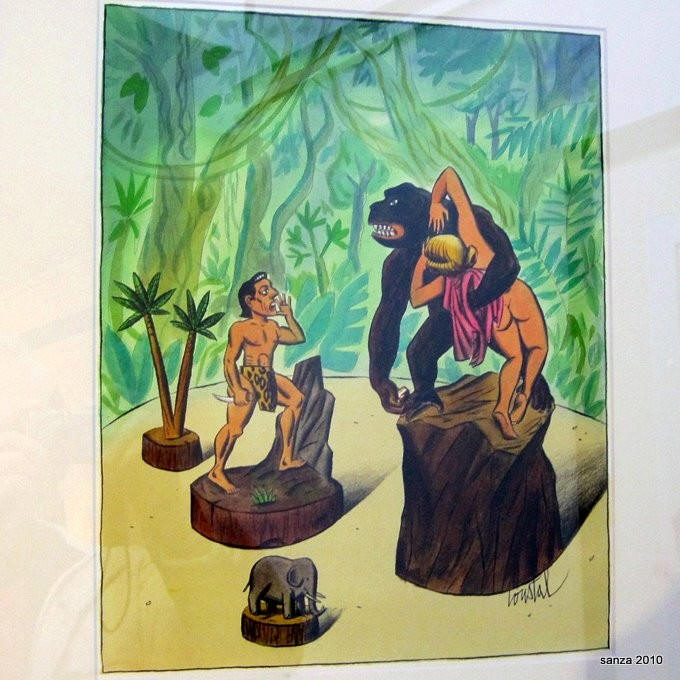2009 Tarzan
Tarzan sauve Jane / Loustal
Exposition au musée du Quai branly du 16 juin au 13 septembre 2009
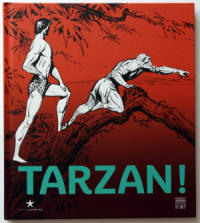 .
.
EXHIBITION CATALOGUE
- Number of pages: 128 pages
- Print: four colours
- Illustrations: approximately 70 illustrations
- Authors: Pascal Dibie, Pascal Ory, Serge Tisseron, Louis-Jean Clavet,
Charles Tesson
Jacques
de Loustal, André Juillard, Frank Pé et François Avril, etc.
- Recommended retail price: €19,50
ISBN-9782757202739
paru le 17 juin 2009.
Loustal, F. Avril
* PRACTICAL INFORMATION:
WWW.QUAIBRANLY.FR
Tarzan !
Exposition. Paris, Musée du quai Branly (2009)
dirigé par Pascal Dibie
préface de Stéphane Martin
Editeur : Somogy
Date de parution : 17/06/2009
Thème : Beaux-arts Art Esthétique
ISBN : 978-2-7572-0273-9
Gencod : 9782757202739
Format : 25 x 28 cm
120 pages, 70 illustrations
Prix : 19,50 EUR
cartonné contrecollé
Représentation mythique de l'homme sauvage, le personnage de Tarzan a nourri
les imaginaires de plusieurs générations, en traversant tous les continents
et en rencontrant des peuples dont la mémoire est notamment conservée dans
les collections du musée. Grâce à cet album consacré à une icône de
l'imagerie populaire, le public découvre les voies de la création du héros
et décrypte le mythe que Tarzan incarne. Au fil d'un véritable parcours
initiatique, le lecteur est emmené de la genèse du personnage à sa postérité
sous les formes les plus variées. A partir de l'œuvre de Edgar Rice
Burroughs, père fondateur du personnage de Tarzan, succèdent depuis un
siècle les déclinaisons du héros (bande dessinée, cinéma, affiches,
figurines, disque et jeu). L'ensemble des témoignages graphiques est
complété par le regard plus sérieux d'éminents spécialistes ethnologues,
historiens, psychiatres et sociolinguistes.
coédité avec le musée du Quai branly
EXHIBITION Tarzan 16 juin - 27 septembre 2009
commissaire : Roger BoulayRoger Boulay est anthropologue, spécialiste de
l’art océanien et commissaire d’exposition. Il était en particulier le
commissaire de l'exposition "L'aristocrate et ses cannibales : le voyage en
Océanie du comte Festetics de Tolna, 1893 - 1896" présentée en 2007 au musée
du quai Branly.
« Je suis venu à travers les âges, jaillissant du passé vague et distant, de
la caverne de l’homme primitif… »
« Tarzan pensait à la fragilité de la frontière entre le primitif et le
civilisé ».
Edgar Rice Burroughs
Copyright © by Edgar Rice Burroughs, Inc. All Rights Reserved
Cette exposition, consacrée à une icône de l’imagerie populaire, propose au
public de découvrir les voies de la création du héros, et le décryptage du
mythe qu’il incarne.
Si Edgar Rice Burroughs est le père absolu du personnage de Tarzan, tous
ceux qui le mirent en scène - dans la bande dessinée, le cinéma, l’affiche,
la figurine, le disque, le jeu…- se réfèrent à des imageries et des
représentations collectives qui fondent quelques unes des mythologies les
plus fortes de notre siècle.
L’exposition parcourt les origines et la nature de Tarzan, en tant que
personnage et en tant que mythe (de Saturnin Farandoul, documentaire de
1914, à Greystoke en 1983), et réhabilite le personnage en tant que héros
contemporain de défense de la nature.
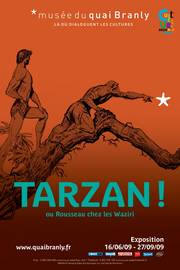
TARZAN TM and EDGAR RICE BURROUGHS TM owned
by Edgar Rice Burroug hs, Inc. and Used by Pe rmission
1
TARZAN!
or Rousseau and the Waziri
16/06/09 - 27/09/09
Exhibition Portfolio
East Suspended Gallery
Exhibition curator: Roger Boulay
Set design: Agence Fantastic – Stéphane Maupin and Nicolas Hugon
Original soundtrack: Cyril Lefebvre and Claire Thiebault
Tarzan was real literary phenomenon from the very first book published in
1912, and soon appeared in comic strips, radio programmes, television series
and films. The character, who
features in many media such as posters, figurines, CDs and even games,
continues to fascinate and fuel our vision of an imaginary,
fantasy Africa.
In the exhibition Tarzan! or Rousseau with the Waziri, the Musée du Quai
Branly, in collaboration with the Centre International de
la Bande Dessinée et de l’Image (International Centre for Comic Books and
Image), explores the myth embodied by this popular
icon.
Through a series of objects from the collections of several French museums,
as well as original comic strips, photos, excerpts of films, etc., the
exhibition allows the public to discover the legend
of Edgar Rice Burroughs’ famous character in the collective images and
representations he embodies, which are the cornerstones of some of the
greatest legends of our age.
* EDGAR RICE BURROUGHS
Edgar Rice Burroughs was born in 1875 in Chicago. At first he wanted to
enter the military, but gave up after failing the entrance exam for West
Point. He then had a string of jobs that gave him his taste for adventure:
train conductor, gold miner, etc. He then began writing, and published his
first novel Under the Moons of Mars in 1912 in the “All Story” magazine. In
October of the same year, Tarzan of the Apes was published, the first of the
26 novels about the famous “Ape-man”.
Edgar Rice Burroughs died in 1950, having published more than 90 volumes in
his lifetime, and having created other legendary characters found in the
tales of Venus, the Pellucidar cycle and the adventures of John Carter.
“It was as though I had been suddenly snatched back through countless ages
to a long-dead past, and dropped into the midst of the prehistoric life of
my Paleolithic progenitors”
“Tarzan thought of the fragile frontier between the primitive and the
civilised”.
Edgar Rice Burroughs
TARZAN TM and EDGAR RICE BURROUGHS TM owned by Edgar Rice Burroug hs, Inc.
and Used by Permission
* THE MYTH OF TARZAN
Edgar Rice Burroughs had never been to Africa, but in creating Tarzan, he
was inspired by many
legends, characters such as the jungle boy in Rudyard Kipling’s Jungle Book,
the good savage,
the lost Eden, the myth of the Great Ape (King Kong) or even the ancient
Greek hero Hercules.
He made Tarzan a real modern Western superhero/superman living in an
imaginary and idealised Africa in which he accomplishes increasingly
incredible exploits in adventure after adventure.
Edgar Rice Burroughs was quick to understand that the art of story telling
in the 20th century was not limited to literature. He very quickly sold the
rights to his novels to the Hollywood studios, and actively participated in
the film adaptations. Since then, the Tarzan character has directly inspired
fifty-odd films (including the famous performances by Johnny Weissmuller as
a statuesque Tarzan, and by Christopher Lambert, cast as a romantic hero) as
well as comic strips (particularly those by Burne Hogarth, whose talent,
inspiration and fascination with the body in movement made him the master of
the comic strip renewal and the forefather of many later artists), video
games, CDs, games, as well as numerous imitations of the character (Tarou,
Akim, Zembla and even Rahan). Nowadays, Tarzan remains an instantly
recognisable figure through the characteristics that contribute to his
iconic status: the vines, the leopard skin loincloth and his unique cry.
Leopard claw amulet (Ethiopia)
© musée du quai Branly
* THE EXHIBITION
The exhibition Tarzan! or Rousseau with the Waziri is built on several
themes, representative of the universe of Edgar Rice Burroughs’ character,
enriched by many objects from the collections of the Musée du Quai Branly,
as well as the Louvre, the musée d’Orsay and the museums Fontainebleau,
Poissy and the Cité Internationale de la Bande dessinée in Angoulême.
The exhibition opens with an object showing Hercules shooting a bow and
arrow, reminding
visitors of the parallel between the two heroes who had to use strength and
courage to overthrow evil in an imaginary and reconstructed universe.
Throughout the exhibition, visitors are immersed in an atmosphere that
mirrors Tarzan’s world, thanks to a specially created original soundtrack, a
collection of comic strip images (including Burne Hogarth’s original
plates), stuffed
wild animals and excerpts from
Hollywood films.
Visitors discover Tarzan’s universe through several themes,
including Film and Tarzan, The Jungle, Tarzan’s Africa (with the Zulu,
Masai, Kikuyu and leopard-men wearing the skins of big cats, Lego-like
characters reflecting colonial imagery), the son of Mother Nature (in
parallel with the myth of Romulus and Remus), the twelve labours of Tarzan (evoking
the mythical hero Hercules), the saviour of the jungle (a proecology anti-hunting
figure who was contrary to the ivory traffickers and other slave traders who
were popular at the time), as well as numerous parodies making light of
Tarzan.
The exhibition ends with the robot from
Metropolis (Fritz Lang, 1927), symbol of the mechanical hero who invades the
urban landscape. Tarzan represents the anti-robot, the naked man faced with
the decadence of modern cities.
* CURATOR
Roger Boulay, a Doctor of Ethnology, was director of the Oceania Collections
in the Musée National des Arts d’Afrique et d’Océanie (National Museum of
African and Oceanian Arts), and was entrusted with the museum programme of
the Tjibaou Cultural Centre in Nouméa. Until 2008, he was responsible for
the Oceanian collections at the Direction des Musées de France and the
museums of Tahiti and New Caledonia for the creation of museum exhibitions
and projects to inventory heritage.
He was curator of the exhibition Kannibals et Vahinés (Cannibals and
Vahinés) at the Musée
National des Arts d’Afrique et d’Océanie (MNAAO) in 2001, and the exhibition
Festetics de Tolna,
l’aristocrate et ses cannibales (Festetics de Tolna, the aristocrat and his
cannibals), at the Musée du
Quai Branly from 23 October 2007 to 13 January 2008.
2010
"Exposition Fétiches & compagnie"
Tarzan sauve Jane
TARZAN! AU MUSEE DU QUAI BRANLY AVEC UNE DEDICACE DE LOUSTAL |
|
|
|
